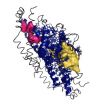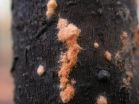(Press-News.org) INDIANAPOLIS – A School of Science at Indiana University-Purdue University Indianapolis biophysicist has developed a new method to identify communication pathways connecting distant regions within proteins.
With this tool, Andrew J. Rader, Ph.D., assistant professor of physics, has identified a mechanism for cooperative behavior within an entire molecule, a finding that suggests that in the future it may be possible to design drugs that target anywhere along the length of a molecule's communication pathway rather than only in a single location as they do today. The discovery holds promise for increasing the likelihood of therapeutic success.
The study, "Correlating Allostery with Rigidity" is published in the current issue of Molecular BioSystems, a journal of the Royal Society of Chemistry.
Microorganisms frequently contain enzymes, protein molecules that carry out most of the important functions of cells, not present in human cells. Blocking these enzymes can stop or kill a harmful invader.
Drugs are often developed to block or restrict the function of such enzymes, thereby treating the underlying infectious disease they convey. These drugs often target specific chemical sites on bacterial or viral enzymes, and alter the enzymes so they no longer function. Unfortunately, microorganisms can evolve enzymes that are impervious to these drugs, resulting in drug resistant organisms.
"With the growth of drug resistant organisms, it is increasingly important that we gain a better understanding of what makes enzymes within cellular proteins do what they do, so that we can develop alternative approaches to targeting these proteins, shutting down enzymes and killing these superbugs," said Rader, first author of the study.
He has found that the "poking" of one spot on the rigid pathway connecting regions within proteins produces communication along the entire pathway, indicating that drugs could be targeted to multiple locations on the pathways that had not developed drug resistance and could travel to where needed. His new method identified more than twice as many communication pathways as previous studies.
To use the analogy of a railroad track, dislocating a single rail, anywhere on the track, effects the entire track as trains cannot travel from one end to the other due to the rail that is out of alignment. Returning the rail to its proper location makes the entire track function normally. In the case of the rigid pathways within proteins, affecting a single chemical locus on the pathway affects the entire pathway.
"We now see in these rigid pathways that we can effect something at a distance. This holds great potential for drug targeting. We can do something at one site on the pathway, where drug resistance is not an issue, and it will affect another, perhaps turning an enzyme off and eliminating drug resistance. It's too early to say whether we can successfully counter tuberculosis, Methicillin-resistant Staphylococcus aureus [MRSA] and others of the growing number of multidrug resistant organisms this way, but it's a promising approach well worth further exploration," said Rader.
INFORMATION:
This study by Rader, co-authored by graduate student Stephen M. Brown, was funded by the Department of Physics, School of Science at IUPUI.
Mol. BioSyst., 2011, 7, 464-471
The School of Science at IUPUI is committed to excellence in teaching, research and service in the biological, physical, behavioral and mathematical sciences. The School is dedicated to being a leading resource for interdisciplinary research and science education in support of Indiana's effort to expand and diversify its economy. For more information, visit www.science.iupui.edu
Communication pathways within proteins may yield new drug targets to stop superbugs
2011-02-01
ELSE PRESS RELEASES FROM THIS DATE:
Wild rainbow trout critical to health of steelhead populations
2011-02-01
CORVALLIS, Ore. – Genetic research is showing that healthy steelhead runs in Pacific Northwest streams can depend heavily on the productivity of their stay-at-home counterparts, rainbow trout.
Steelhead and rainbow trout look different, grow differently, and one heads off to sea while the other never leaves home. But the life histories and reproductive health of wild trout and steelhead are tightly linked and interdependent, more so than has been appreciated, a new Oregon State University study concludes.
The research could raise new challenges for fishery managers ...
Nanosilver: A new name -- well-known effects
2011-02-01
Numerous nanomaterials are currently at the focus of public attention. In particular silver nanoparticles are being investigated in detail, both by scientists as well as by the regulatory authorities. The assumption behind this interest is that they are dealing with a completely new substance. However, Empa researchers Bernd Nowack and Harald Krug, together with Murray Heights of the company HeiQ have shown in a paper recently published in the journal Environmental Science & Technology that nanosilver is by no means the discovery of the 21st century. Silver particles with ...
Morning after pill linked to increase in STIs, study shows
2011-02-01
Offering the morning after pill free over the counter has not reduced the number of teenage pregnancies and may be associated with a rise in sexually-transmitted diseases (STIs), according to a report by experts at The University of Nottingham.
Professors David Paton and Sourafel Girma used local health authority data to study the impact that the introduction of Government-backed schemes to offer emergency birth control at pharmacies and without prescription have had on conception rates and the diagnosis of STIs among under-18s.
Their findings show that, on average, ...
CERN announces LHC to run in 2012
2011-02-01
Geneva, 31 January 2011. CERN today announced that the LHC will run through to the end of 2012 with a short technical stop at the end of 2011. The beam energy for 2011 will be 3.5 TeV. This decision, taken by CERN management following the annual planning workshop held in Chamonix last week and a report delivered today by the laboratory's machine advisory committee, gives the LHC's experiments a good chance of finding new physics in the next two years, before the LHC goes into a long shutdown to prepare for higher energy running starting 2014.
"If LHC continues to improve ...
Red Bull logo enough to shape consumer performance
2011-02-01
Chestnut Hill, Mass. (1/31/2011) – Red Bull's red and gold logo can "give you wings" – for better or worse – even if consumers don't know it, according to a new study by two Boston College professors, who found the brand's edgy marketing efforts have sold a heavy dose of attitude to consumers.
Researchers put subjects at the controls of a car racing video game, supplying each with functionally identical racecars, but each car decorated with a different brand logo and color scheme.
Players put in control of the Red Bull car displayed the characteristics often attributed ...
Specific populations of gut bacteria linked to fatty liver
2011-02-01
The more we learn about biology, the closer we get to being able to treat disease – and the more complicated our understanding of disease itself becomes.
A new research finding showing a strong relationship between complex microbial ecologies in human intestines and the common but serious medical condition known as fatty liver illustrates this paradox.
From past genomic studies, we have learned that a mind-boggling multitude of different kinds of benign bacteria inhabit our intestines and that these populations can vary almost infinitely from one human being to the ...
Free radicals in cornea may contribute to Fuchs dystrophy, most common cause of corneal transplants
2011-02-01
Boston, MA—Scientists have found that free radicals (unstable molecules that cause the death of cells as the body ages) may also cause the damage in the eyes of patients with Fuchs Endothelial Corneal Dystrophy (FECD), a hereditary disease that is one of the most common reasons for corneal transplants worldwide.
The finding, published in the November 2010 American Journal of Pathology, holds promise for early and preventative treatments for this disease, which impacts nearly four percent of the population over age 60.
"Our discovery is significant, because it gives ...
Analysis of bread mold genomes demos 'reverse-ecology' tool
2011-02-01
Berkeley – In a demonstration of "reverse-ecology," biologists at the University of California, Berkeley, have shown that one can determine an organism's adaptive traits by looking first at its genome and checking for variations across a population.
The study, to be published the week of Jan. 31 in the journal Proceedings of the National Academy of Sciences, offers a powerful new tool in evolutionary genetics research, one that could be used to help monitor the effects of climate change and habitat destruction.
The researchers scanned the genes of 48 different strains ...
Hunt for dark matter closes in at Large Hadron Collider
2011-02-01
The scientists have now carried out the first full run of experiments that smash protons together at almost the speed of light. When these sub-atomic particles collide at the heart of the CMS detector, the resultant energies and densities are similar to those that were present in the first instants of the Universe, immediately after the Big Bang some 13.7 billion years ago. The unique conditions created by these collisions can lead to the production of new particles that would have existed in those early instants and have since disappeared.
The researchers say they are ...
Scientists synthesize long-sought-after anticancer agent
2011-02-01
New Haven, Conn.—A team of Yale University scientists has synthesized for the first time a chemical compound called lomaiviticin aglycon, leading to the development of a new class of molecules that appear to target and destroy cancer stem cells.
Chemists worldwide have been interested in lomaiviticin's potential anticancer properties since its discovery in 2001. But so far, they have been unable to obtain significant quantities of the compound, which is produced by a rare marine bacterium that cannot be easily coaxed into creating the molecule. For the past decade, different ...


